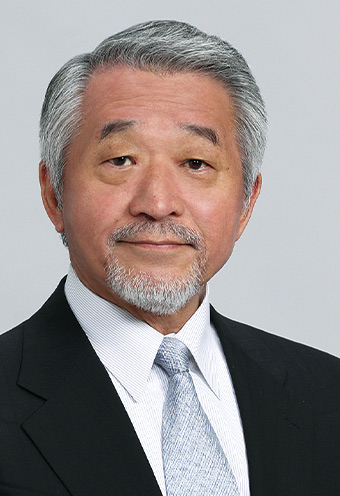
Profile
- Bachelor of Engineering, Doctor of Engineering, Nagoya University (Department of Information Engineering)
- Professor Emeritus, Osaka University, Former Professor, Osaka University, Former Professor, Toyohashi University of Technology, Former Visiting Associate Professor, University of South Carolina
- IEEE Lifetime Member, IEEE Standard Association Member, IFIP Silver Core Member, IFIP TC 10 WG 10.5 Member, Fellow of the Japan Society for Information Processing, Fellow of the IEICE, Visiting Member of the Semiconductor & Systems Design Technology Committee of the Japan Electronics and Information Technology Industries Association (JEITA), Representative Director of ASIP Solutions, Inc.
Responsible Subject
- IoT and Wireless Networks
- Master Project
Field of Specialization
- Design optimization method for electronic system
- instruction set processor development technique
- Application of LSI Technology to Medical Care
Business Performance
Books
- "Practical software etiquette" by Naohiko TAKEDA, Gen OIWA, Masaharu IMAI, et al., CQ Publishing Co., ISBN 4 -7898 -3474 -3 C 3055, 1988
- "VLSI Design Silicon Compilation" by Naoyuki SUGIYAMA, Supervised by Masaharu IMAI, Naoyuki SUGIYAMA, Masaharu IMAI, et al., Science Forum Co., 1988
- "computer foundation engineering" by Masakata SOWA, Masakata SOWA, Ryuro YANASE, Masaharu IMAI, et al., Shokodo ISBN 4 -7856 -3081 -7, 1992
- "Basic and application of ASIC technology" written (Corona) by Masaharu IMAI and others, ISBN 4 -88552 -119 - X, 1994
- Masaharu Imai, Yoshinori Takeuchi, Norimasa Ohtsuki, and Nobuyuki Hikichi, “Compiler Generation Techniques for Embedded Processors and their Application to HW/SW Codesign,” in Ahmed A. Jerraya and Jean Mermet (Eds.), System-Level Synthesis, pp. 293-320, Kluwer Academic Publishers, ISBN 0-7923-5748-5, 1999.
- Yuki Kobayashi, Yoshinori Takeuchi, and Masaharu Imai,”ASIP Meister” in Prabhat Mishra and Nikil Dutt (Eds.) Processor Description Languages, Chapter 7, Springer, ISBN978-0-12-374287-2, 2008.
- Ittetsu Taniguchi, Masaharu Imai, and Francky Catthior, Design Methodology for Reconfigurable Processors, Lap Lambert Academic Publishers ISBN 978 -3 -8383 -8928 -8, 2011
- "Logic circuit" by Masaharu IMAI, Masaharu IMAI, Teruo TONO, Yoshinori TAKEUCHI, Masayoshi HASHIMOTO, Omsha ISBN 978 -4 -274 -21806 -4, 2016
8 others
Academic Paper
- Yoshinori Takeuchi, Masaharu Imai, “Very Tiny Inner Bladder Pressure Sensing System for Long Term Ambulatory Urodynamic Monitoring,” Trans. of Japanese Society for Medical and Biological Engineering, Vol. 51, p. M-119, Oct. 2013.
- Salita Sombatsiri, Yoshinori Takeuchi and Masaharu Imai, “An Efficient Performance Estimation Method for Configurable Multi-layer Bus-based SoC," IPSJ Trans. on System LSI Design Methodology, Vol.8, pp. 26-37, 2015.
- Yuuka Hirao, Jaehoon Yu, Yoshinori Takeuchi, Masaharu Imai, "Arrhythmia Detection Using a Deformable Part Model and Time Domain Features," in Proc. of International Workshop on Smart Info-Media Systems in Asia (SISA 2016), pp. 94–99, 2016, (SISA Best Student Paper Award).
- Tomoki Sugiura, Arif Ullah Khan, Jaehoon Yu, Yoshinori Takeuchi, Seiji Kameda, Takatsugu Kamata, Yuki Hayashida, Tetsuya Yagi and Masaharu Imai, "A Programmable Controller for Spatio-temporal Pattern Stimulation of Cortical Visual Prosthesis," in Proc. of IEEE Biomedical Circuits and Systems Conference (BioCAS 2016), pp. 432–435, Shanghai, China, 2016.
- Tomoki Sugiura, Masaharu Imai, Jaehoon Yu, Yoshinori Takeuchi, “A Low-Energy Application Specific Instruction-Set Processor towards a Low-Computational Lossless Compression Method for Stimuli Position Data of Artificial Vision Systems,” Journal of Information Processing, Vol. 25, pp. 210–219, 2017.
200 or more other works
Translation
- M. Imai, K. Watanabe, T. Yokota, K. Seo (Translation), "A Comparative Study of RISC Architectures," Nikkei Business Publications, ISBN 4-8222-7135-8, 1992.Original author : Stephen B. Original author : Furber, "VLSI RISC Architecture and Organization", Marcel Dekker, Inc., 1989.
- Masaharu Imai and Akihiko Yamada (Translation) "VHDL," Mentor Graphics Japan K.K., ASCII Publishing, ISBN 4-7561-1906-9, 1996.Original author : Douglas L. Original author : Perry, "VHDL, Second Edition", McGraw-Hill, Inc., 1994.
Patent
- Masaharu Imai, Yoshinori Takeuchi, Keishi Sakanushi, Takashi Hamabe, Kazunori Kimiya, Kimiaki Abe, "Error correction code processing method and its device", Patent Application No. 2012 -514716 (Page 2012 -514716), International Application No. PCT/JP2011/002639, International Application Date: May 11, 2011.
- Yoshinori TAKEUCHI, Masaharu IMAI, Shoko NAKATSUKA, "Method and device for compressing biological information" Tokkai 2015 -88911 (P 2015 -88911 A), May 7, 2015.
Awards
- IEEE Life Member
- ACM Service Award
- IFIP Silver Core
- Fellow of the Information Processing Society of Japan
- Japan Society of Electronics, Information and Communication Engineers Merit Award
- Society of Electronics, Information and Communication Engineers Fellow
- Takahiro Nozu, Hirofumi Iwato, Takuji Hieda, Huynh Long Kim, Hiroaki Tanaka, Atsushi Sato, Akiyoshi Shiomi, Akira Kitajima, Keishi Sakanushi, Yoshinori Takeuchi, Masaharu Imai, Best Poster Award, SWEST 7 Executive Committee
- Masaharu Imai, Incentive Award of LSI IP Design Award "One Day Designed Processor", IP Award Steering Committee
- Masaharu Imai, Shiro Kobayashi, Hiroaki Tanaka, Yoshinori Takeuchi, Keiji Sakanushi, LSI IP Design Award Incentive Award "Block floating point processor core for developing signal processing application in short period"
- Hiroki Osawa, Hirofumi Iwato, Kanehiro Kondo, Keishi Sakanushi, Yoshinori Takeuchi, Masaharu Imai, Akira Matsuzawa, Yoshihiko Hirao, "IEEE Solid-State Circuits Society Japan Chapter Academic Research Award," IEEE Solid-State Circuits Japan Chapter
- Ittetsu Taniguchi, Murali Jayapala, Praveen Raghavan, Francky Catthior, Keishi Sakanushi, Yoshinori Takeuchi, and Masaharu Imai "The IEEK Semiconductor & Device Society paper award," The Institute of Electronics Engineers of Korea
- Teruaki Tanaka, Yoshinori Takeuchi, Masaharu Imai, Best Paper Award "Modeling Method of Real-Time Control System Using Shared Resource Model Description", Information-Technology Society, Embedded Systems Symposium (ESS) 2016